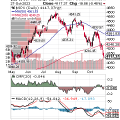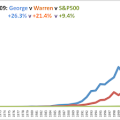As the Christmas season approaches, traditionally marked by increased discretionary spending, retailers anticipate a much-needed boost. The consumer discretionary sector has faced considerable challenges in recent years, with many retailers depending on the festive season for over half of their annual sales.
Although post-Thanksgiving sales have evolved beyond their traditional one-day events, the closing weeks of the fourth quarter remain crucial for retailers seeking to improve their financial health. The National Retail Federation anticipates holiday spending this November and December to achieve record levels, projecting growth between 3% and 4% over 2022 to reach between $957.3 billion and $966.6 billion.
Deloitte’s annual Holiday Retail Survey projects that 2023 consumer spending will exceed pre-pandemic levels for the first time, with the average consumer predicted to spend $1,652 on gifts, up 14% year-over-year.
Interestingly, there is a commonly observed “Santa Claus Rally” phenomenon in the financial market during this period – a seasonal surge in volume and trading that tends to last until Christmas. LPL Financial found that since 1950, a Santa Claus rally has occurred around 79% of the time.
Year-end holiday shopping, driving sales for retailers and related businesses, can increase stock prices. Investors are generally keen on a year-end rally that boosts their portfolios, while professional traders often consider it an influential factor in determining their year-end bonuses. The occurrence of a Santa Claus rally this year could be welcomed, given the sluggish behavior of stocks since August.
Investment focus is shifting toward stocks presenting the most significant opportunities now, with some manifesting more profitability potential than others if acquired before price surges. Many investors are identifying holiday stocks to capitalize on with the holiday shopping season looming.
Given this backdrop, let us delve into an in-depth analysis of consumer discretionary stocks Amazon.com, Inc. (AMZN), Walmart Inc. (WMT), Target Corporation (TGT), and Etsy, Inc. (ETSY) now.
As the winter holiday season draws near, e-commerce behemoth AMZN, with a market cap of over $1 trillion, is ramping into full festive gear. The Seattle-based firm hosted its recent Prime Day event on October 10 and 11, further revealing plans to enfold 250,000 additional personnel across its global operations in anticipation of the busy year-end shopping frenzy.
AMZN’s biannual Prime Days are effective levers for amplifying revenue. The July event yielded over $12 billion worth of sales – a record-breaking feat that crowned it the most successful Prime Day ever. Striving to expand the holiday shopping duration, the company has been progressively ushering its secondary Prime Day event into the fourth quarter.
The impact extends beyond just the Prime Days. The company also greatly benefits from the surge in sales during the Black Friday and Cyber Monday promotions tied to the Thanksgiving holiday, offering substantial financial reinforcements. The company forecasted revenue between $160 billion and $167 billion for the current holiday quarter. However, analysts polled by LSEG were expecting revenue of $166.62 billion, at the higher end of AMZN’s guidance.
AMZN has restructured its delivery network in its retail operations to strategically position goods closer to customers, allowing for faster, more cost-effective order fulfillment. The enhancement of its same-day delivery services has positively influenced its profit margins by encouraging shoppers to place orders more frequently and in larger quantities.
For the fiscal fourth quarter ending December 2023, its revenue is expected to increase 11.2% year-over-year to $165.86 billion, while EPS could reach $0.76, up significantly year-over-year.
On the stock market front, shares of AMZN have appreciated over 69% year-to-date and are trading above the 50-, 100-, and 200-day moving averages – an apparent sign of a bullish trend.
Echoing these encouraging prospects, Wall Street analysts expect the stock to reach $176.13 in the next 12 months, indicating a potential upside of 24%. The price target ranges from a low of $145 to a high of $230.
Initially established as a conventional brick-and-mortar retailer, WMT has become an influential omnichannel contender. The company’s strategic acquisitions of Bonobos, Moosejaw, and Parcel and its partnerships with industry giants Shopify and Goldman Sachs underscore this evolution. Further efforts, such as introducing delivery programs Walmart + and Express Delivery and investing in Flipkart – an acclaimed online e-commerce platform – exemplify these changes.
These mechanisms have strengthened the retail behemoth’s position, allowing it to remain resilient within the dynamic landscape of the retail industry. The company’s adaptive initiatives ensure continuous relevancy and competitiveness in this changing ecosystem.
The prominent discount retailer goes the extra mile for the holiday season, employing additional personnel and offering round-the-clock service from Thanksgiving to Christmas to accommodate last-minute shoppers. The company notably profits from Black Friday, Cyber Monday, and Boxing Day promotions, with attractive offers ranging from electronics and toys to clothing.
WMT’s in-store and virtual purchases witnessed a substantial escalation during the holiday season, complemented by an upswing in the market.
WMT’s second-quarter financial performance exceeded Wall Street predictions, and the company elevated its full-year guidance. Propelled by robust grocery sales and enhanced online expenditure, the retailer registered a remarkable second-quarter earnings per share of $1.84, while revenue touched $161.63 billion.
The retail giant revealed a 24% year-over-year growth in its e-commerce sales during the second quarter of 2023, with same-store sales observing a 6.4% uptick. WMT anticipates a 4% to 4.5% overall surge in annual sales.
For the fiscal fourth quarter ending January 2024, its revenue is expected to increase 3.6% year-over-year to $158.42 billion, while EPS is anticipated to reach $1.66.
Shares of WMT have gained over 15% year-to-date and trade above the 50-, 100-, and 200-day moving averages, indicating an uptrend. Moreover, Wall Street analysts expect the stock to reach $180.46 in the next 12 months, indicating a potential upside of 9.8%. The price target ranges from a low of $165 to a high of $210.
Boasting a market cap exceeding $51 billion, TGT has demonstrated robust financial health in 2023, successfully safeguarding its profit margins amid a challenging retail environment. The firm maintained solid earnings and cash flow despite subdued consumer spending in fundamental areas like home décor.
As holiday shoppers navigate TGT’s illustrious aisles, they are presented with the retailer’s holiday price match guarantee – a strategy aimed at streamlining shopping experiences while offering optimal pricing. Frequently running comprehensive sales on daily essentials and holiday requisites – from electronics to clothing and household goods, TGT facilitates economical purchases, countering rising inflationary pressures.
TGT adopts a strategic stance this festive season by emphasizing affordability in its holiday marketing schemes. Guided by the motto “However You Holiday, Do It For Less,” TGT links everyday items within its seasonal collection, providing an affordable range for consumers facing economic challenges.
Recognizing that 75% of TGT customers initiate their digital shopping journeys on mobile platforms, the corporation has augmented its investment in digital channels by 20% in 2023, specifically focusing on media mix optimization throughout the holiday period. This concerted effort towards optimizing digital footprint hones in on social media.
Furthermore, TGT’s innovative advertising campaigns encapsulate broad holiday themes like “Lights,” “Magic,” and “Style,” demonstrating their application across various product categories. These aspirational campaigns aim to inspire consumers as they prep for holiday social events, alongside fulfilling their routine shopping needs.
Enhancing its product offering, TGT has introduced thousands of new items this year, expanding from toys priced at $25 to affordable $1 stocking stuffers. The corporation spotlights partnerships with renowned brands, including Fenty Beauty, Kendra Scott, and Mattel and private label introductions like the recent Figmint kitchen range.
For the fiscal fourth quarter ending January 2024, its revenue and EPS are expected to increase 1.2% and 19.4% year-over-year to $31.77 billion and $2.26, respectively.
Wall Street analysts expect the stock to reach $145.03 in the next 12 months, indicating a potential upside of 32%. The price target ranges from a low of $105 to a high of $180.
Renowned as a premier online hub for handcrafted and vintage goods, ETSY is an ideal platform for consumers looking for inventive gift options, particularly during the bustling winter holiday season. The broad spectrum of products available on ETSY – from jewelry and clothing to toys and home décor – caters to the preferences of its 97.3 million active users offered by 8.8 million energetic sellers.
However, this year has posed significant challenges for ETSY. ETSY grapples with unfavorable financial outcomes, unlike its competitors, who have rebounded from pandemic-induced downturns. The company experienced another decline following the release of its third-quarter earnings report.
ETSY’s unique business model – a marketplace that emphasizes handcrafted and vintage items and operates via network effects and switching costs – may be attractive, but ultimately, consistent growth is vital to sustain investor interest. While ETSY insists on its distinct positioning within a large potential market, its struggle to bolster gross merchandise sales (GMS) post-pandemic suggests that the demand for its products may be more limited than anticipated.
Growth in GMS was barely perceptible in the third quarter at just 1.2% year-over-year to $3 billion. GMS per active buyer was down 6% to $127, possibly reflecting the economic challenges.
Moreover, the company estimated GMS for the fourth quarter of 2023 to decline in the low-single-digit range year-over-year. This could deteriorate into a mid-single-digit drop if financial circumstances worsen and stabilize or marginally increase if conditions improve.
CEO Josh Silverman said, “There’s no doubt that this is an incredibly challenging environment for spending on consumer discretionary items. It’s therefore important to acknowledge that this volatile macro climate will make it challenging for us to grow this quarter.”
Yet, amid this financial gloom, bright spots are visible for ETSY. For the fiscal third quarter that ended September 30, 2023, active buyers on the ETSY marketplace witnessed a 4% year-over-year increase, totaling 91.6 million, with growth in U.S. active buyer trends for the first time in seven quarters. The company has reactivated 6 million buyers, marking a 19% year-over-year uptick, and retention rates exceed pre-pandemic levels.
Simultaneously, ETSY’s seller base surged 19% to 8.8 million overall. An additional 400,000 sellers have joined the Etsy marketplace in the quarter, bringing its total to 6.7 million. These sellers may use the platform to supplement their income amid inflationary and other economic strains.
However, it is crucial to point out that even though other discretionary retailers are grappling with the prevailing economic climate, ETSY continues to underperform compared to its e-commerce competitors. This inevitably prompts queries regarding when or whether we might witness a resurgence in ETSY’s growth on par with its peers.
For the fiscal fourth quarter ending December, its revenue and EPS are expected to increase 1.7% and 16.2% year-over-year to $820.69 million and $1.33, respectively. Wall Street analysts expect the stock to reach $74.39 in the next 12 months, indicating a potential upside of 16.3%. The price target ranges from a low of $50 to a high of $125.



